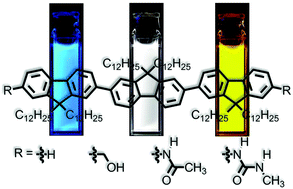Oligofluorene-based nanoparticles in aqueous medium: hydrogen bond assisted modulation of functional properties and color tunable FRET emission†
Abstract

* Corresponding authors
a
Organic Materials Group, Polymer Materials Unit, National Institute for Materials Science (NIMS), 1-2-1 Sengen, Tsukuba 305-0047, Japan
E-mail:
TAKEUCHI.Masayuki@nims.go.jp
Fax: +81-29-859-2101
Tel: +81-29-859-2110

 Please wait while we load your content...
Something went wrong. Try again?
Please wait while we load your content...
Something went wrong. Try again?
B. Balan, C. Vijayakumar, S. Ogi and M. Takeuchi, J. Mater. Chem., 2012, 22, 11224 DOI: 10.1039/C2JM30315A
To request permission to reproduce material from this article, please go to the Copyright Clearance Center request page.
If you are an author contributing to an RSC publication, you do not need to request permission provided correct acknowledgement is given.
If you are the author of this article, you do not need to request permission to reproduce figures and diagrams provided correct acknowledgement is given. If you want to reproduce the whole article in a third-party publication (excluding your thesis/dissertation for which permission is not required) please go to the Copyright Clearance Center request page.
Read more about how to correctly acknowledge RSC content.
 Fetching data from CrossRef.
Fetching data from CrossRef.
This may take some time to load.
Loading related content
